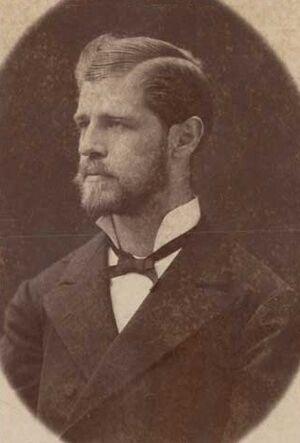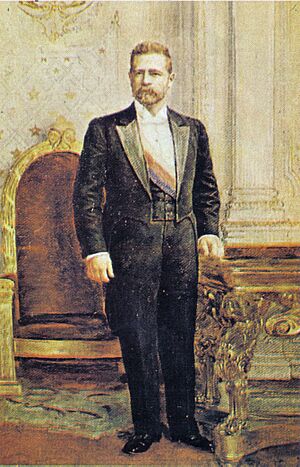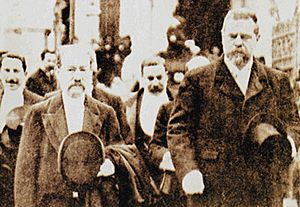Germán Riesco facts for kids
Quick facts for kids
Germán Riesco Errázuriz
|
|
|---|---|

Germán Riesco, c. 1906
|
|
| 13th President of Chile | |
| In office September 18, 1901 – September 18, 1906 |
|
| Preceded by | Aníbal Zañartu Zañartu |
| Succeeded by | Pedro Montt Montt |
| Personal details | |
| Born | May 28, 1854 Rancagua, Chile |
| Died | December 8, 1916 (aged 62) Santiago, Chile |
| Political party | Liberal |
| Spouse | María Errázuriz Echaurren |
| Signature | |
Germán Riesco Errázuriz was an important political leader from Chile. He served as the President of Chile from 1901 to 1906. He was born on May 28, 1854, and passed away on December 8, 1916.
Contents
Early Life and Career
Germán Riesco was born in Rancagua, Chile. His father, Mauricio Riesco, was a Spanish merchant. His mother, Carlota Errázuriz Zañartu, was the sister of a past president, Federico Errázuriz Zañartu.
He studied at the Seminario Conciliar and the University of Chile. When he was just 17, he started working as a clerk at the Ministry of Justice. This job helped him support his family.
He became a lawyer on April 19, 1875. In 1880, he was promoted to chief clerk at the ministry. He married his cousin, María Errázuriz Echaurren, in the same year. This made him the brother-in-law of future president Federico Errázuriz Echaurren.
Later, he worked in the court system. He became a clerk for the Appeals Court of Santiago in 1891. Then, in 1897, he became a clerk for the Supreme Court. He left his work in the courts in 1898 to work as a private lawyer.
Becoming President of Chile
Germán Riesco first entered politics when he was elected as a senator for Talca in 1900. After President Federico Errázuriz Echaurren suddenly died, a group called the Liberal Alliance chose Riesco as their candidate for president. This happened on March 8, 1901.
The Liberal Alliance included different political groups like the radicals, democrats, and liberals. Even though Riesco was more of a conservative, they supported him. Some groups, especially those linked to the church, were against him. They even started a campaign saying he was a "threat against religion."
However, Riesco won the election by a large number of votes. Many people voted for him because he was not very involved in politics before. He had spent most of his life working in the courts. He himself said that he "wasn't a threat to anybody," which made him appealing to many. He officially became president on September 18, 1901.
Key Actions as President
As president, Germán Riesco faced many challenges. The parliament, which is like the country's law-making body, was very divided. He had to appoint 17 different governments during his term. Each government lasted only about three and a half months on average.
Even though the Liberal Alliance helped him get elected, they later stopped supporting him. He had to seek help from the Conservative Coalition, who were his former opponents. He often had to switch between supporting different groups to finish his term. Because he didn't have a strong majority in congress, he had to appoint temporary ministers. These ministers often couldn't get much done.
Legal and Public Works Reforms
Since Riesco used to work in the courts, he focused a lot on improving the country's laws. He helped create a new Code of Civil Procedure in 1902, which is still used today. He also created a new Code of Penal Procedure in 1906. This law lasted for almost 100 years.
In 1905, he started building a new home for the Supreme Court. This building was finished in 1911. He also completed other important public projects. These included new sewer systems for Santiago and a new network of electric trams. He also greatly improved education, especially for girls. He doubled the number of schools that trained new teachers.
Economic Challenges
During his presidency, prices for goods started to rise a lot. This is called inflation. Because of this, he had to allow the government to print more paper money. This decision caused the value of money to drop even more. It also led to higher inflation, which made people more upset and caused social problems.
International Relations
President Riesco worked to improve Chile's relationships with other countries.
Peace with Neighbors
At the end of 1901, Chile and Argentina were almost at war because of disagreements over their borders. Both countries were building up their navies. However, they chose to solve their problems peacefully. They signed the May Treaties on May 28, 1902. They also agreed to let someone else decide on their border in Patagonia later that year. These agreements also connected the telegraph lines between both countries.
He signed a final peace treaty with Bolivia on October 20, 1904. This officially ended the War of the Pacific. He also started talking with Peru again in 1906. This was to help solve a disagreement about the areas of Tacna and Arica.
Claiming Antarctica
President Riesco also took the first steps to claim part of Antarctica for Chile. He issued a law that set rules for seal-hunting there.
Social Unrest and Protests
During Riesco's time as president, social problems became very serious. Between 1903 and 1905, there were many strikes across the country. Workers like miners, ship-loaders, railroad workers, and even police officers went on strike. Many of these protests ended with people getting hurt or even dying.
The Meat Riots
On October 22, 1905, many poor people in Santiago marched to protest the high price of meat. The government had made meat expensive by adding a special tax on cattle imported from Argentina. This was to help local farmers. Also, high inflation made things worse. Many people could not afford meat.
The march started peacefully and reached the presidential palace, La Moneda. The crowd grew to about 25,000 to 30,000 people. They wanted to speak with President Riesco, but he did not appear. People became impatient. When the police tried to break up the crowd, people fought back and tried to enter the palace.
The police shot at the crowd, and riots began. The violence lasted for almost a week, with widespread looting. This event was called the Meat Riots or the red week. Many protesters were hurt or died during this time. This showed that the country's social problems were much worse than the leaders thought.
Antofagasta General Strike
A few months later, a similar protest happened in Antofagasta. Workers building the Antofagasta-Bolivia railroad asked for better conditions. The company refused their demands, so the workers started a general strike.
Because of what happened during the Meat Riots, the government sent soldiers and a warship to Antofagasta. On February 6, 1906, about 3,000 workers gathered in a public square to protest. The troops fired on the unarmed workers. This resulted in many deaths and injuries.
The Valparaíso Earthquake
A major earthquake hit Valparaíso on August 16, 1906. Ten days before, the head of the Navy's weather office had warned about it. The day of the earthquake started clear but later became rainy. As the sun set, and many people were eating dinner, the first strong shake hit. It lasted for about four minutes.
After the first shock, people started looking for survivors. About fifteen minutes later, a second, stronger shock hit the city. This one lasted about a minute and completed the city's destruction. Most of the city was leveled, and many people died. Some looting also happened. The governor declared martial law, meaning anyone caught looting was immediately shot.
All communication lines were cut, isolating the city. News reached Santiago, which is only 120 kilometers away, the next afternoon. Three days later, on August 20, the ministers of Interior and War managed to reach the port. President Riesco and the newly elected Pedro Montt arrived on August 25. They had to travel by train, on foot, and by horseback to reach the destroyed city.
Germán Riesco died in Santiago on December 8, 1916. He was 62 years old and died from a heart problem.
See also
 In Spanish: Germán Riesco para niños
In Spanish: Germán Riesco para niños




